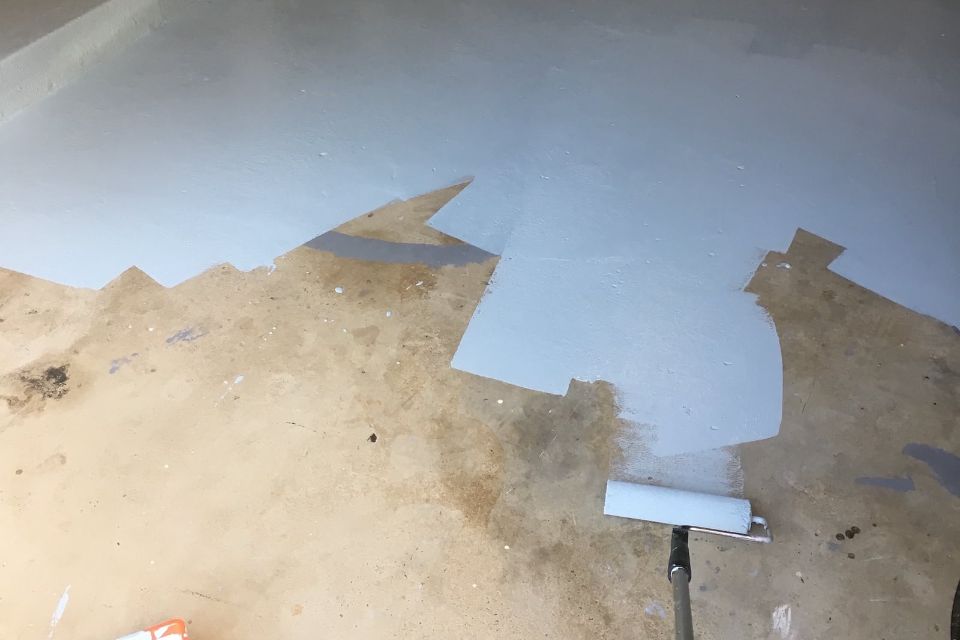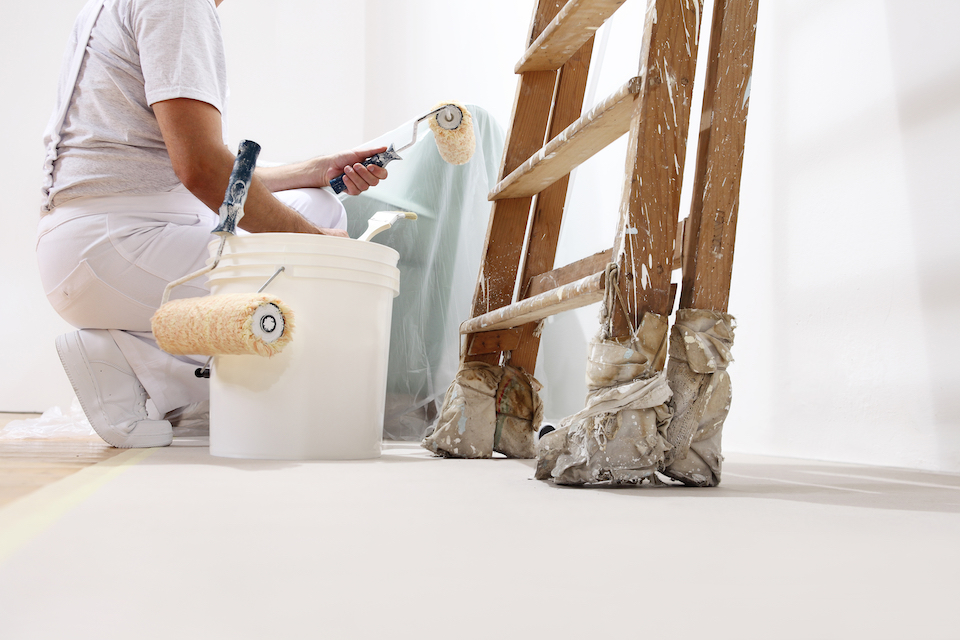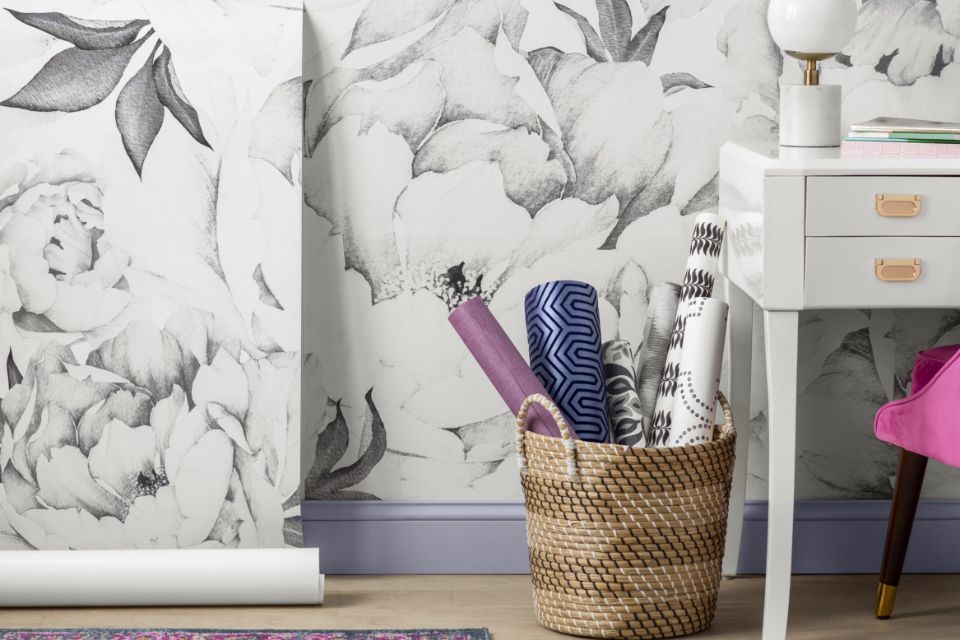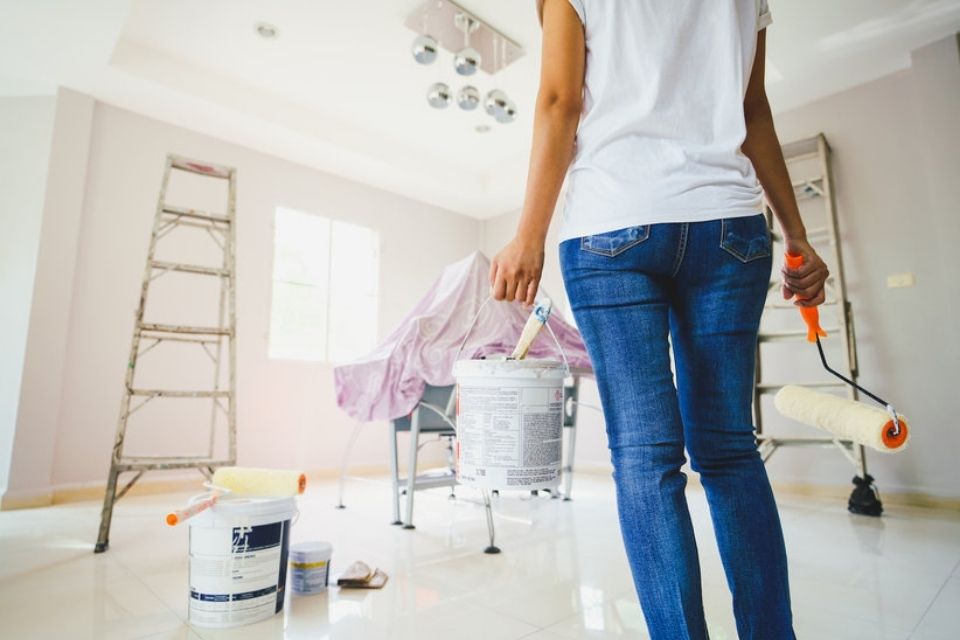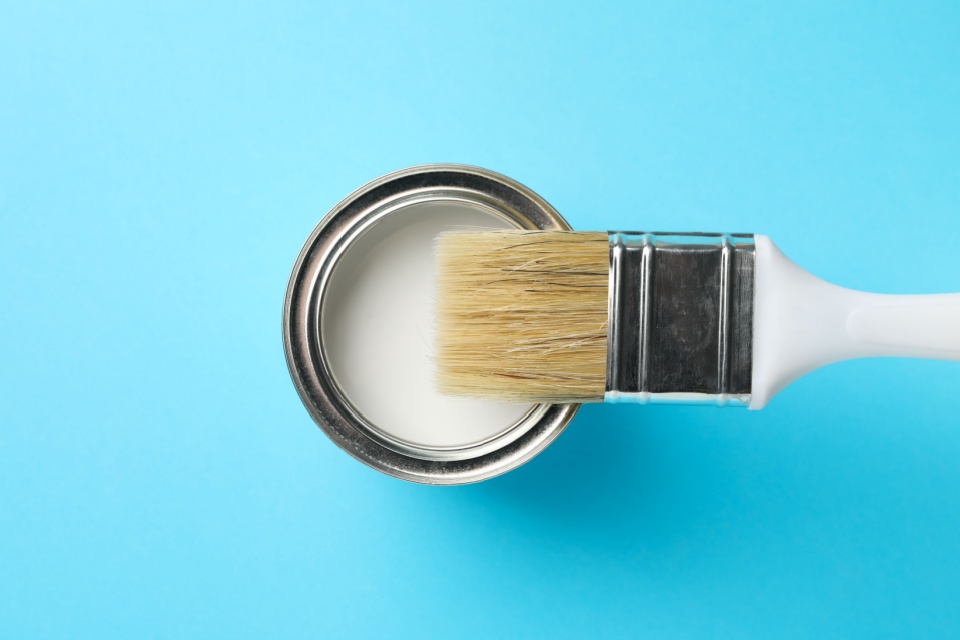Introduction to the Best Paint for Garage Floor
A garage floor sees a lot of wear and tear between the cars, tools, and bicycles wheeled in for storage.
Though tough and durable, the surface will eventually reflect the abuse it takes over time.
Water or extreme temperatures might cause it to crack, and vehicle fluids and a slew of other chemicals might cause other stains.
Eventually, these defects will wreck the appearance of your garage floor and put it at risk of more severe damage, such as crumbling or fires.
Types of Paint
There are many different types of paints, and each type has their own special uses that might make it more suitable for you than an other.
Here we will be looking through the main types of paint, and the benefits and downsides to them all.
Alkyd
Alkyd is a type of oil-based paint which contains alkyd – a modified polyester material that acts as the main resin in oil-based high-gloss coatings. Alkyd paint normally costs around £8 to £10 per litre.
The main benefit of alkyd paint is that it is highly durable and resistant to wear and tear, stains and moisture damage, which is perfect for a garage floor.
It is also ideal for high-traffic areas, as stains do not absorb easily, making this type of paint very easy to clean.

One of the disadvantages of alkyd paint is that it contains a high level of volatile organic compounds (VOCs) which are toxic chemicals that can be harmful to the environment.
When using alkyd paint, you need to make sure that your garage is ventilated properly to prevent any issues, especially if you have children, are pregnant or have any breathing difficulties.
Pros:
- Highly durable to wear and tear.
- Highly resistant to stains.
Cons:
- Contains toxic chemicals that could damage the environment.
Single pack epoxies
Single pack epoxy paint is made up of epoxy resin which allows the paint to adhere to the surface better. Single pack epoxy tends to be priced at around £30 to £45 per litre.
The main benefit of using single pack epoxies is that it does not contain a hardener and is, therefore, more eco-friendly than double pack epoxies.
Despite not being as durable as double pack epoxies, it is still highly resistant to oil and petrol staining, as well as tyre lifting and peeling.
In comparison to two-pack epoxy paint is not as durable and may require multiple layers to ensure it is long-lasting. This also means it is susceptible to scratches and additional damage, so it may be best for a garage with low foot traffic.
Pros:
- Eco-friendly.
- Resistant to wear and tear.
Cons:
- Not as durable as double pack epoxies.
- May need to paint multiple layers to get a desirable effect.
Double pack epoxies
Double or two-pack epoxy paint is made up of two elements including a base and hardener which is used by professional decorators to paint high-traffic areas. This type of paint normally costs around £12 to £90 per litre.
One of the main advantages of two-pack epoxy paint is that it is one of the most durable paint options, especially for concrete and steel flooring.
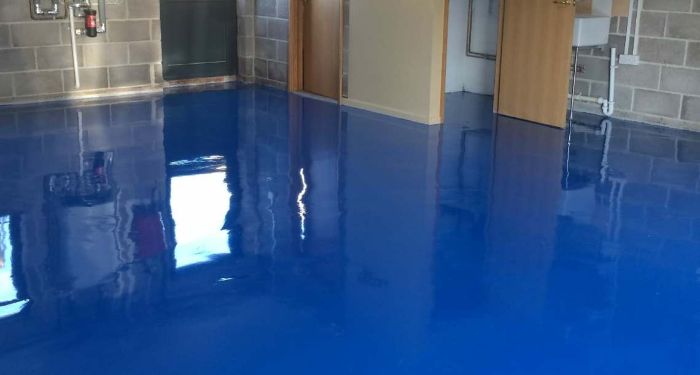
This type of paint is usually self-priming, so there is no need to apply an undercoat.
An issue with double pack epoxy paint is that it produces a high level of VOCs and an overpowering odour that makes the application process difficult, so you are best hiring a professional when using this type of paint.
Pros:
- One of the most durable paints.
- Self-priming.
- Great for high foot traffic.
Cons:
- Expensive.
- Powerful odour not for the squeemish.
Polyurethane
Polyurethane paint is basically made up of a liquid plastic which dries to create a hard-wearing coating. You can expect to pay around £8 to £15 per litre for polyurethane paint.
Polyurethane cures into a hard and durable surface which makes it is ideal for garage flooring. It is also resistant to water and chemical damage, as well as adverse weather conditions and UV rays, which makes it more sustainable.
The problem with polyurethane paint is that it does take a long time to dry in between coats, as you need to ensure that the polyurethane has completely cured before applying another layer.
Polyurethane polymers in liquid form are also highly flammable and can be toxic, so it is important that they are applied in a well-ventilated garage.
Pros:
- Perfect for garage floor.
- Resistant to water and chemical damage.
Cons:
- Takes a long time to dry.
- Highly flammable and toxic.
Polyaspartic coatings
One of the most expensive garage floor options is polyaspartic paint which normally costs around £30 to £40 per litre.
This type of paint is a hybrid coating that is similar to polyurethane, although it is much more flexible and does not require a primer.
The main advantage of polyaspartic paint is that it offers the strongest level of protection against chemical spillage in high-traffic garages.
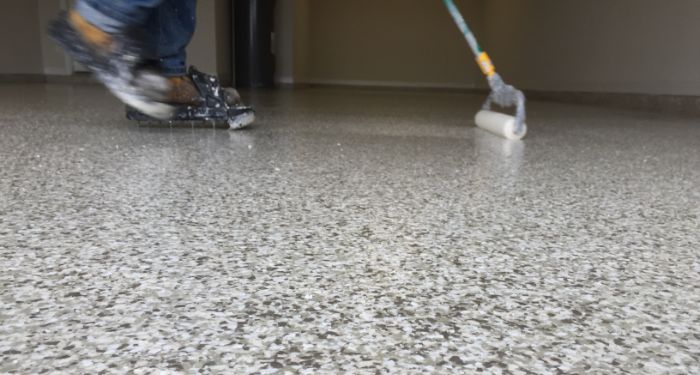
It can also be applied in a temperature lower than -10°C, unlike other garage floor paints.
The downside of choosing polyaspartic coatings is that the cost of paint and preparation expenses are significantly high.
There are also limited colours available, so your garage colour scheme may be restricted.
Pros:
- Strongest level protection.
- Can be applied in freezing temperatures.
Cons:
- Expensive.
- Limited colour choice.
Best Paint for Garage Floors
If you have never painted your garage floor, then you may be unsure of which paint and brands are the best. Some of the best paint for a garage floor includes:

Ronseal Diamond Hard Garage Floor Paint
One of the best floor paint products is Ronseal’s Diamond-Hard Garage Formula which is a water-based acrylic paint that provides a barrier against dust build-up and is ideal for medium-traffic garages.
You should expect to pay around £8 per litre for slate or white paint.
The benefits of this paint are that it offers a significant level of protection against oil spills, dirt, dust and grease, as well as being very easy to clean.
It is also a quick-drying garage floor paint, as it only takes around two hours to touch dry and you can apply another layer within just six hours.
In comparison to solvent-based paints, this water-based paint is not as resistant, especially for floors that come into contact with hot tyres, as Ronseal’s product can be susceptible to lifting.
Pros:
- Protection against dust build-up.
- Excellent protection against an array of messes.
- Quick dry time.
Cons:
- Not very resistant compared to counterparts.
Rust-oleum 9700 Coldmax Rapid
This product is a polyaspartic coating which is a premium type of garage floor paint.
The cost of Rust-oleum 9700 Coldmax Rapid is around £30 per litre, with colour options including silver grey, light grey and white.
According to garage floor paint UK reviews, this is a heavy-duty paint which offers the highest level of protection against chemical and traffic damage. It can also be applied at temperatures -10°C or above.

The main disadvantage of this paint is that it is a lot more expensive than other garage floor paints, which includes the price of the product as well as the extensive preparation.
There are also limited colour options, so you may have to opt for durability over aesthetics.
Pros:
- Excellent protection.
- Can be applied at below freezing temperatures.
Cons:
- Expensive.
- Limited colour options.
Everbuild Concrete Hardener and Dust-Proofer
One of the most affordable garage floor paints is Everbuild’s formula which costs around £7 for five litres.
This has a clear finish which is made up of silicate resins that work well with the lime in concrete floors to create a highly-durable surface.
This product is one of the most fact-acting garage floor paints which provides a dust-proof residual surface that prevents future damage. The clear sheen also offers extensive durability without changing the existing colour of the garage floor.
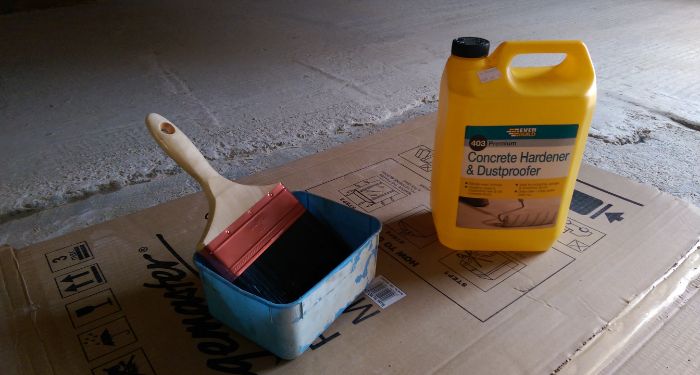
Everbuild Concrete Hardener and Dust-Proofer takes at least 24 hours to dry, however, if your garage is poorly ventilated then may need to wait longer.
It is also extremely hard to remove, so you should think carefully about your choice before making it permanent.
Pros:
- Very affordable.
- Very durable.
- Fast acting.
Cons:
- May be permanent.
Jotun Jotafloor Rapid Dry
Jotun’s garage floor paint is an alkyd paint which is available in various colours including grey, cream, white, red and black. This paint costs around £8 per litre depending on the colour you choose.
The main advantage of this paint is that it is very easy to apply and has a fast-drying process. You can also add aggregate to the paint to enhance the aesthetic and grip, which will make your garage floor more durable.
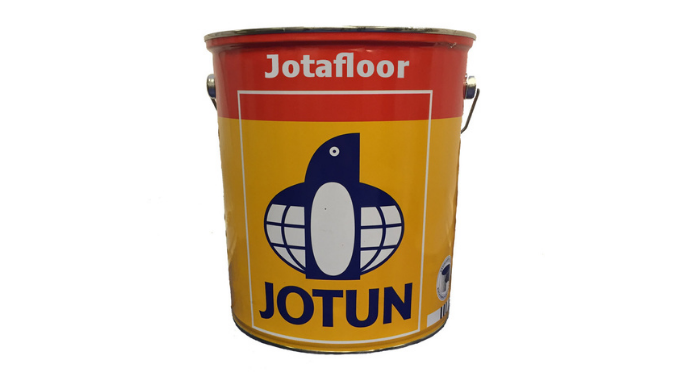
If you have a garage floor that has been installed for two years or less, then you should not apply Jotun Jotafloor Rapid Dry as it may cause damage to a concrete floor that has not set properly.
Pros:
- Very affordable.
- Easy to apply.
Cons:
- May cause damage to new floors.
Leyland Trade Floor Paint
According to garage floor paint reviews, Leyland Trade is one of the most popular brands in the UK, and its floor paint is one of their popular products due to its extensive durability.
This floor paint has a satin-sheen, and the formula is made up of polyurethane alkyd resins which is ideal for garages with light to medium foot traffic. It is also available in slate, red and grey.
This paint can be purchased for around £50 for a 5 litre tub which is ideal for medium to large garages.
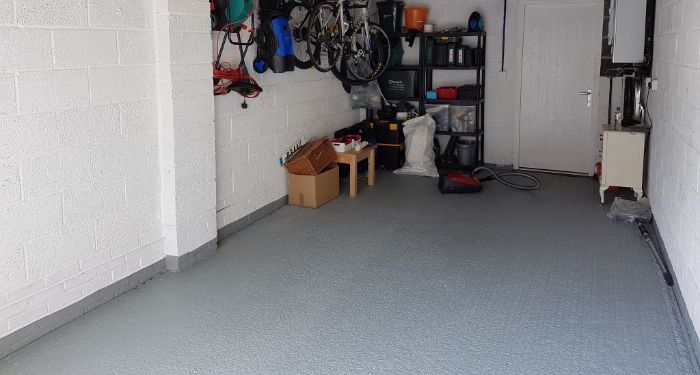
Leyland Trade Floor Paint also offers impressive coverage, so two coats of paint are usually enough to cover the average garage floor.
The issue with this paint is that it is classified as an alkyd paint which has a high level of volatile organic compounds which may be harmful to children, pregnant women and those who have breathing difficulties, as well as damaging to the environment.
Due to the toxicity, you need to make sure that your garage is properly ventilated before painting to reduce the risk of harm.
Pros:
- Most popular brand.
- Incredibly durable.
Cons:
- Can be toxic.
- Needs ventilation when applying or can be harmful.
Benefits of Painting Your Garage Floor
Before painting your garage floor, you may want to consider the following benefits:
Aesthetically-pleasing
Garages tend to look drab and are usually used as a place to park your car or a room where you can store all your unwanted goods, however, if you want to update the look of your garage, painting the garage floor is the best way to do it.
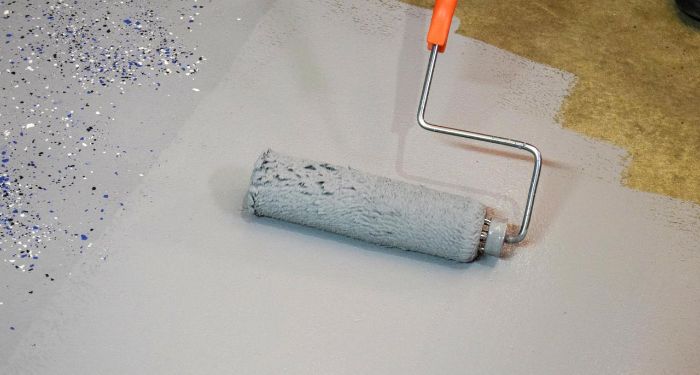
You may want to paint your floor if you plan to use your garage as a fitness room or you simply just want to make your garage more appealing to look at. It will also enhance the lighting in your garage, especially if you choose a light or bright colour.
Dust-proofing
You may be surprised to know that garage floor paint can actually make your floor more resistant to dust.
This is especially important if you have a concrete floor, as concrete tends to attract a significant amount of dust which is a hassle to clean.
By painting your garage floor, you can prevent a build-up which will not only look better but will also reduce the amount of time on sweeping your garage floor.
Reduced maintenance
Concrete garage floors are also susceptible to cracking in both hot and cold weather conditions; however, by applying a layer or two of paint, then this will prevent cracks and therefore decrease garage floor maintenance.
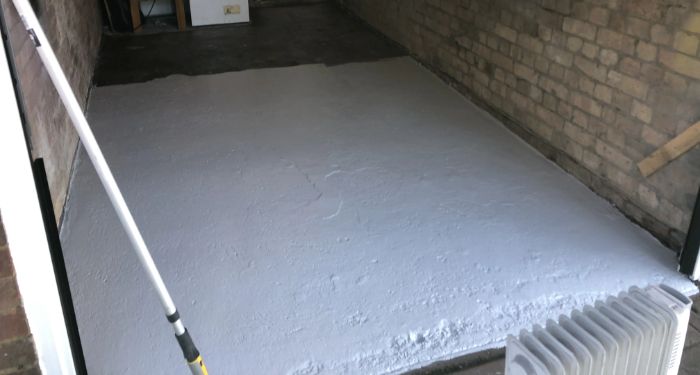
The reduction of cracks will also help you reduce cleaning hours, as you will not have to clear out the cracks in your garage floor.
Long-lasting
One of the main benefits of painting your garage floor is that it can actually add on ten years to your floor’s lifespan.
This is due to the added protection it provides, as the majority of garage floor paint is resistant against dust, mildew, moisture and more.
Garage floor paint is also extremely resistant against tyre peeling and chemicals such as petrol, oil spills and more damage due to its extensive durability.
How Much Garage Floor Paint Will I Need?
Before purchasing paint, you need to measure the width and height of your garage floor, as on average, you need around one litre of paint per eight to ten square metres.
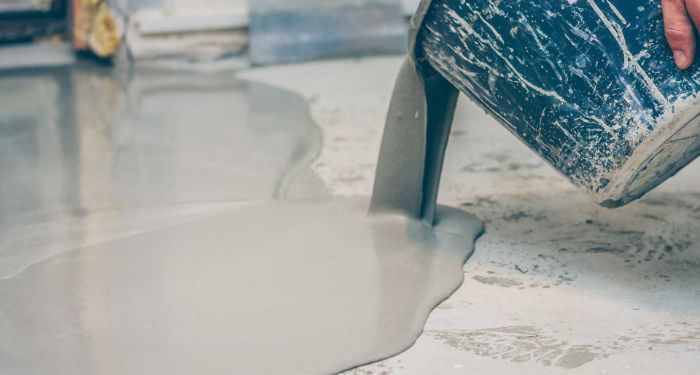
You should multiply the final number by two as a normal application usually involves two coats of paint to ensure your garage floor is durable and long-lasting.
FAQs
Q. How do I remove garage floor paint?
A: If you wish to remove paint from your concrete garage floor, you will need to purchase an appropriate paint stripper and apply it for the required length of time.
You should then use a scrubbing brush to remove the paint stripper which will remove the majority of the paint.
Once most of the paint has been removed, you should then hose down the area to remove the rest of the paint stripping chemical. If there is any paint left on your garage floor, you should then repeat the process.
Q: Is garage floor paint slippery?
A: While high-gloss garage floor paint may look slippery, it may actually contain anti-slip agents which prevent accidents.
However, less durable garage floor paint may be slightly slippery, so if this is the case, you should apply a sealant with a polymer grit additive which will add grip to your garage floor.
Q: Is garage floor paint waterproof?
A: The majority of garage floor paints are waterproof, especially formulas that contain epoxy, polyaspartic and polyurethane.
This helps prevent water damage with an added weatherproof resistant, which comes in handy during storms or heavy rainfall.
Q: Will garage floor paint work on wood?
A: You should try to avoid using garage floor paint on wood, especially garage floor paint epoxy resin formulas, as these do not adhere to wood as they do to concrete.
However, this does not mean that you should rule it out entirely, as you can apply garage floor paint if you prepare the surface properly by washing, sanding and priming the floor to make the paint adhere better.
Q: How do you clean a garage floor?
A: While applying garage floor paint can reduce maintenance, you should still try to clean it regularly to prevent damage.
This will involve brushing up any dirt or dust, as well as clearing up any spills immediately to avoid damage.
You can also use a pressure washer to remove dirt, although try to avoid using it on a high volume as this could cause the paint or floor to crack.
Sources
- https://www.doityourself.com/stry/pros-and-cons-of-polyurethane-finish
- https://www.promain.co.uk/blog/best-floor-paint-for-garages/
- https://www.jonathan-brier.com/alkyd-oil-paints
- https://www.promain.co.uk/blog/best-floor-paint-for-garages/
- https://www.whatpaint.co.uk/by-object/garage-floor
- https://www.sheldonandsons.com/3-benefits-painting-garage-floor/
- https://www.bestgaragefloorcoating.com/why-the-garage-floor-needs-to-be-painted/
- https://www.houstontexaspainters.com/benefits-painting-garage-floors/
- https://www.ronseal.com/for-home/floor-care/garage-floor-paint/diamond-hard-garage-floor-paint/
- https://www.paintmaster.co.uk/how-to-remove-floor-paints-and-sealers-n-42.php

